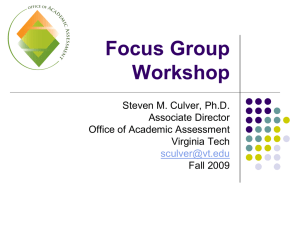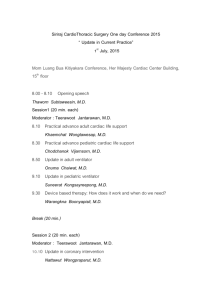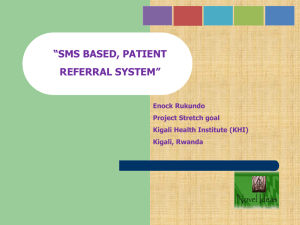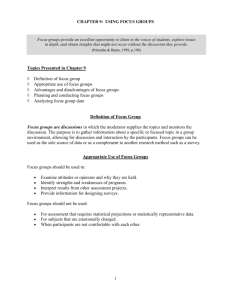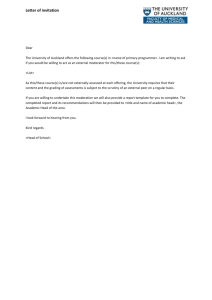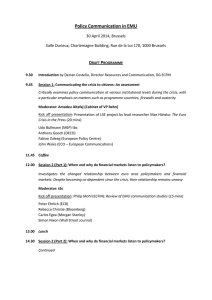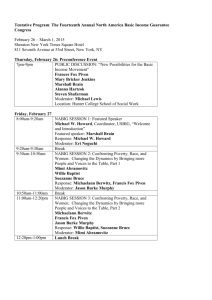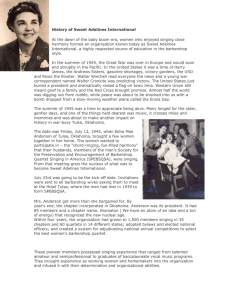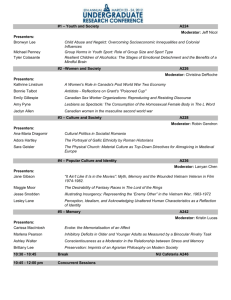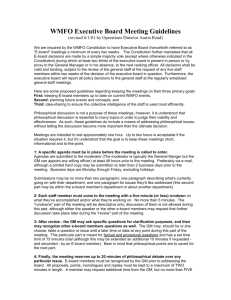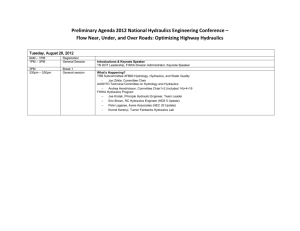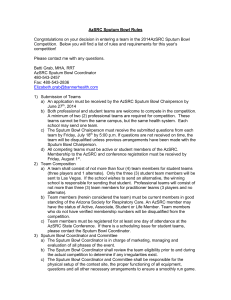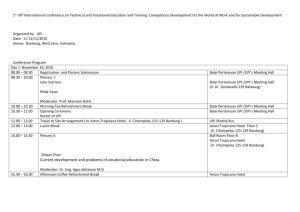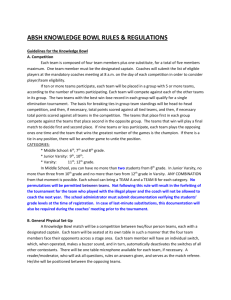A Business Approach to Membership
advertisement
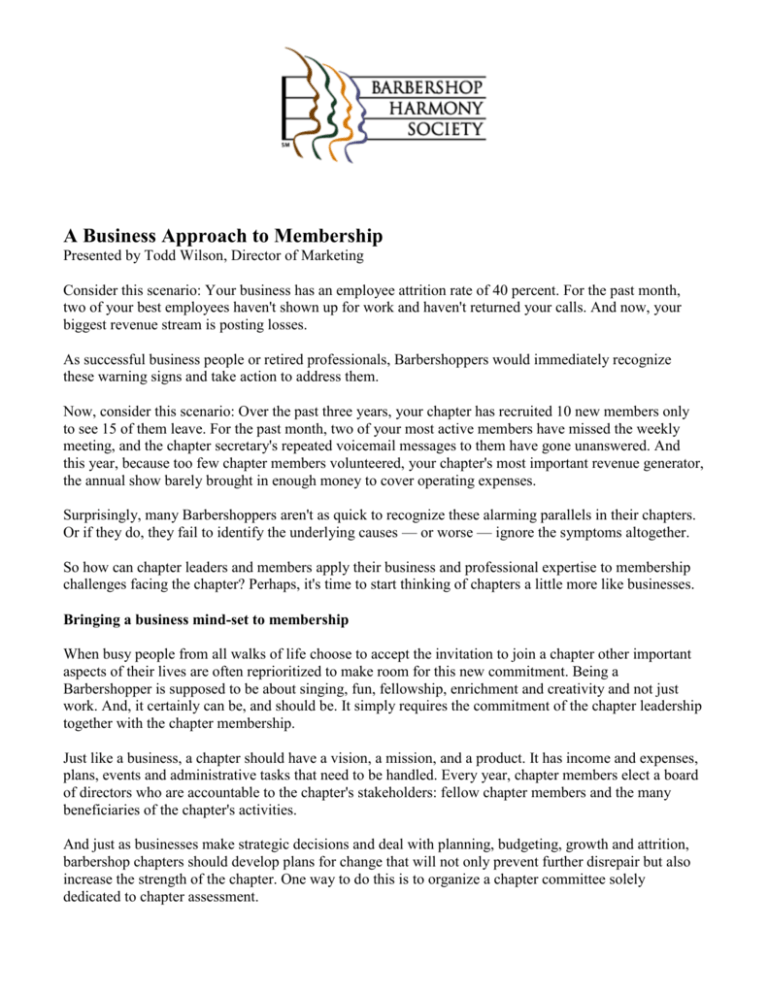
A Business Approach to Membership Presented by Todd Wilson, Director of Marketing Consider this scenario: Your business has an employee attrition rate of 40 percent. For the past month, two of your best employees haven't shown up for work and haven't returned your calls. And now, your biggest revenue stream is posting losses. As successful business people or retired professionals, Barbershoppers would immediately recognize these warning signs and take action to address them. Now, consider this scenario: Over the past three years, your chapter has recruited 10 new members only to see 15 of them leave. For the past month, two of your most active members have missed the weekly meeting, and the chapter secretary's repeated voicemail messages to them have gone unanswered. And this year, because too few chapter members volunteered, your chapter's most important revenue generator, the annual show barely brought in enough money to cover operating expenses. Surprisingly, many Barbershoppers aren't as quick to recognize these alarming parallels in their chapters. Or if they do, they fail to identify the underlying causes — or worse — ignore the symptoms altogether. So how can chapter leaders and members apply their business and professional expertise to membership challenges facing the chapter? Perhaps, it's time to start thinking of chapters a little more like businesses. Bringing a business mind-set to membership When busy people from all walks of life choose to accept the invitation to join a chapter other important aspects of their lives are often reprioritized to make room for this new commitment. Being a Barbershopper is supposed to be about singing, fun, fellowship, enrichment and creativity and not just work. And, it certainly can be, and should be. It simply requires the commitment of the chapter leadership together with the chapter membership. Just like a business, a chapter should have a vision, a mission, and a product. It has income and expenses, plans, events and administrative tasks that need to be handled. Every year, chapter members elect a board of directors who are accountable to the chapter's stakeholders: fellow chapter members and the many beneficiaries of the chapter's activities. And just as businesses make strategic decisions and deal with planning, budgeting, growth and attrition, barbershop chapters should develop plans for change that will not only prevent further disrepair but also increase the strength of the chapter. One way to do this is to organize a chapter committee solely dedicated to chapter assessment. Striking a gentle balance All kinds of people make contributions to your chapter, each in their own way. As Ken Hatton of the Bluegrass Student Union has been known to say, there are three kinds of people in this world: 1. Those that make things happen 2. Those that watch things happen 3. Those that look around and ask…What happened? Some members will tell you they “just want to sing” and get their fill of “work” during the day. Of course, this kind of business approach to chapter management will require your fair share of doers. One way to raise the bar and establish some minimum standards would be for your chapter to establish and communicating some reasonable “expectations of membership” to all existing and incoming members. NEXT ISSUE: Part two of this series deals more with the nuts and bolts of conducting an assessment and outlines three basic activities to help your chapter achieve objectives, whatever they may be. Selecting chapter characteristics Creating and implementing a chapter assessment evaluation plan Selecting chapter members to serve on the assessment committee In part one of this series we focused on the advantages of applying some basic business principles in managing chapter operations; assessing your chapter, identifying problem areas, identifying the underlying causes and formulating a plan of attack to address issues identified. This article deals more with the nuts and bolts of conducting an assessment and three basic activities to help your chapter achieve objectives, whatever they may be. Selecting chapter characteristics Creating and implementing a chapter assessment evaluation plan Selecting chapter members to serve on the assessment committee An assessment-focused chapter To prepare for this chapter assessment, begin by asking chapter members to volunteer for organizational roles and tasks. You'll need individuals to moderate the meeting and plan the meeting's agenda. Other volunteers can arrange for an off-site location, meals, and meeting supplies. Encourage board members to shake off their yoke of responsibility for the day and think of themselves once again as non-elected chapter members. On the day of the meeting, the moderator should begin by underscoring the importance of an objective and thorough assessment of chapter operations and member satisfaction. This should be followed by an overview of the day's agenda: Activity 1: Select chapter characteristics for evaluation — Many chapter characteristics might include: Programming the weekly meeting/rehearsal New Member Recruitment New Member Orientation Membership Retention Administrative Leadership Development Musical Leadership Development Leadership Succession Planning Chapter Planning and Budgeting Chapter Show Production Singing Valentines Activity 2: Select members to serve on a chapter assessment committee to evaluate each characteristic — Moderator asks for volunteers to evaluate each of the chosen characteristics. Activity 3: Develop assessment evaluation plans — Moderator instructs chapter assessment committee members to consider how the following, and more, impact the chapter characteristic they are evaluating: Weekly programs Fellowship events Average chapter member age Cost of membership Singing ability of the ensemble Time commitments for meetings, conventions and performances Organization of chapter and meetings Communication Recruitment The moderator should remind chapter assessment committee members to be as objective as possible in their evaluations, and remind them that the purpose of the chapter assessment is to work together to identify opportunities to make the chapter more relevant to its members and the community. Activity 4: Review of fact finding methods — Moderator highlights strategies such as: Question-and-answer sessions. Suggest that the chapter assessment committee address the subject at an upcoming meeting and facilitate a question-and-answer session from the chapter members to each other and to the Board members. Surveys. By allowing respondents express their opinions confidentially, surveys can provide detail that may not be accessible in a more public forum. Suggest to chapter assessment committee members that they survey active, inactive and former members, and consider surveying guests who attended a meeting but declined the invitation to join. The feedback may be difficult to hear, but the insight gained from their responses may provide the invaluable piece of evidence that turns a chapter from average to outstanding. Visit the “members only” section of www.barbershop.org to download a copy of a few surveys currently available. Focus groups. Someone who's been in the chapter for less than 3 years will likely have a very different perspective from a 15-year veteran. Suggest to the chapter assessment committee that they should look at the chapter characteristic from different member perspectives by conducting informal focus groups with these members, away from the chapter setting. This allows them an opportunity to voice their opinions in a supportive environment. Activity 5: Develop a structure for reporting progress to the entire membership — Some chapter assessment committee groups may be able to complete their evaluation in a few weeks, others may need a few months. To keep interest and commitment high, the moderator should ask for a schedule from each group showing the dates of upcoming chapter meetings during which they will report their progress. After the assessment Once the evaluations are complete, and the chapter assessment committee groups have presented their findings, solutions should be encouraged from the entire membership and implemented. In the workplace, the best results are accomplished with the assistance of many hands and minds. The same is true for maintaining a healthy, vibrant chapter of volunteer members. Getting all members of the chapter involved in its care spreads the burden of responsibility over many shoulders and many minds, and has proven to improve membership retention. It also makes the work of the chapter more fun. By bringing a business mind-set to their chapters and by using some of the same evaluation and survival strategies, Barbershoppers just like you can position their chapters to attract new members, retain existing members, and remain more relevant to the needs of all members and the community they serve.
